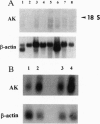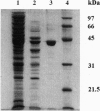Abstract
Adenosine kinase catalyzes the phosphorylation of adenosine to AMP and hence is a potentially important regulator of extracellular adenosine concentrations. Despite extensive characterization of the kinetic properties of the enzyme, its primary structure has never been elucidated. Full-length cDNA clones encoding catalytically active adenosine kinase were obtained from lymphocyte, placental, and liver cDNA libraries. Corresponding mRNA species of 1.3 and 1.8 kb were noted on Northern blots of all tissues examined and were attributable to alternative polyadenylylation sites at the 3' end of the gene. The encoding protein consists of 345 amino acids with a calculated molecular size of 38.7 kDa and does not contain any sequence similarities to other well-characterized mammalian nucleoside kinases, setting it apart from this family of structurally and functionally related proteins. In contrast, two regions were identified with significant sequence identity to microbial ribokinase and fructokinases and a bacterial inosine/guanosine kinase. Thus, adenosine kinase is a structurally distinct mammalian nucleoside kinase that appears to be akin to sugar kinases of microbial origin.
Full text
PDF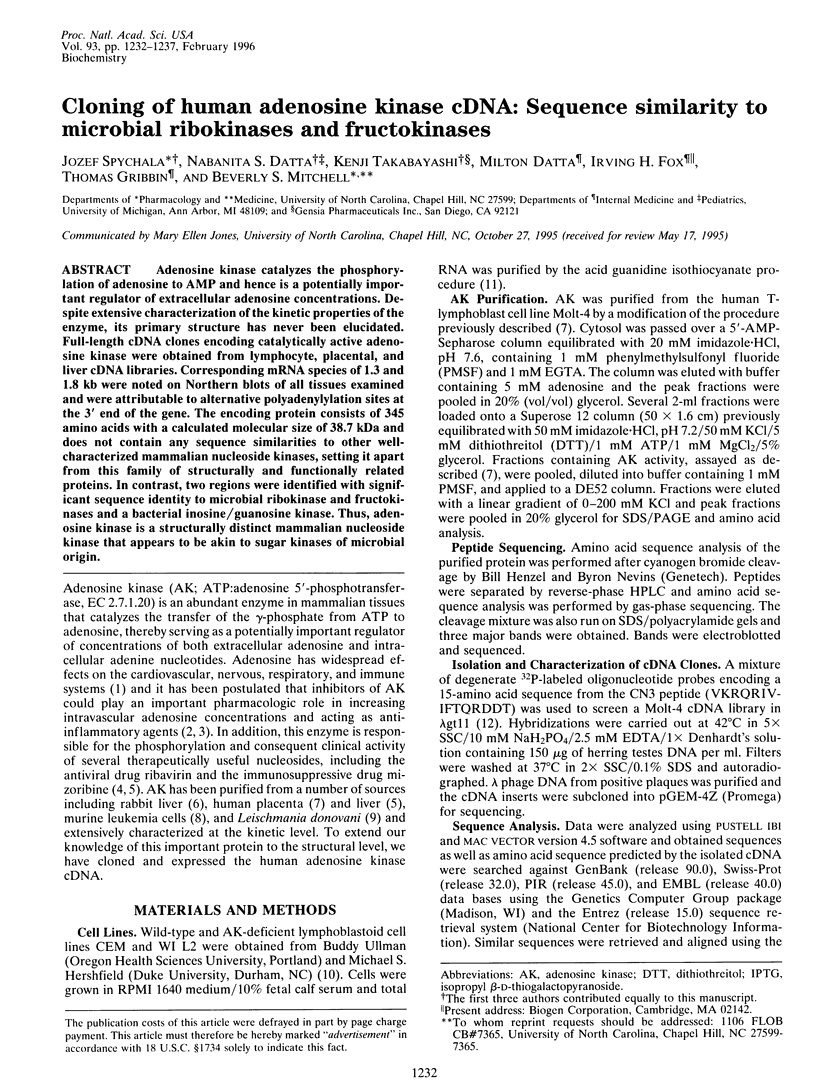
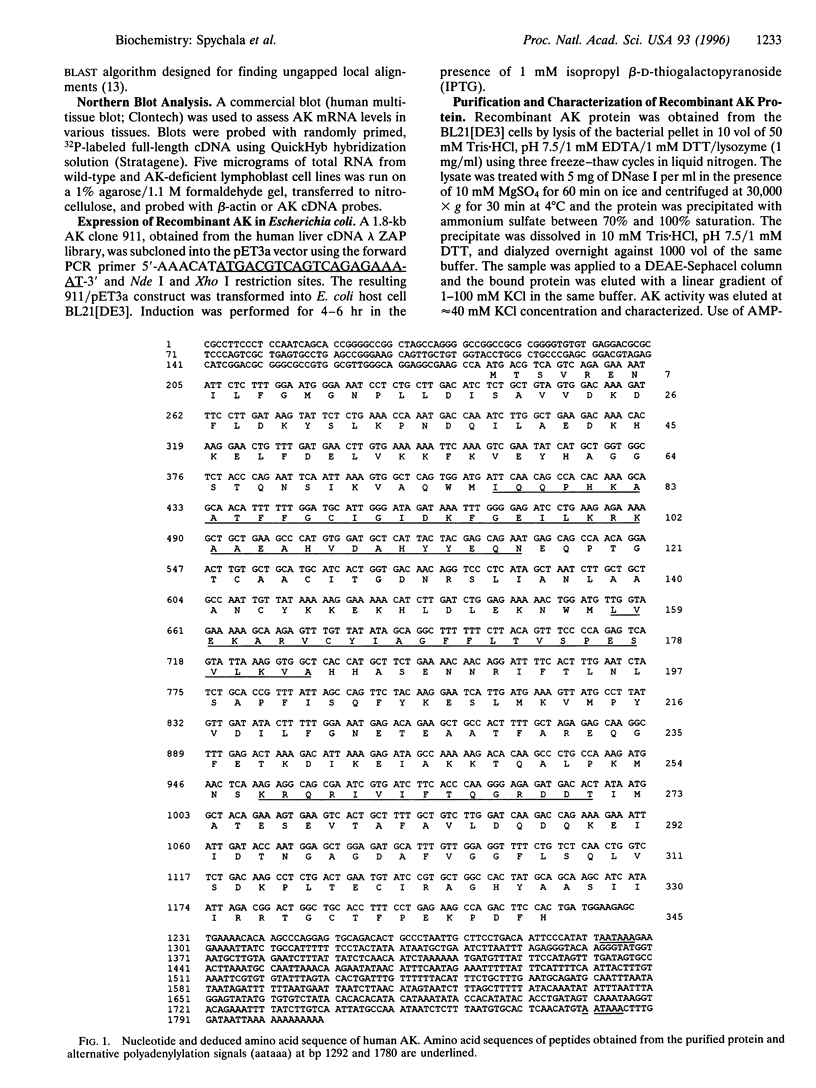

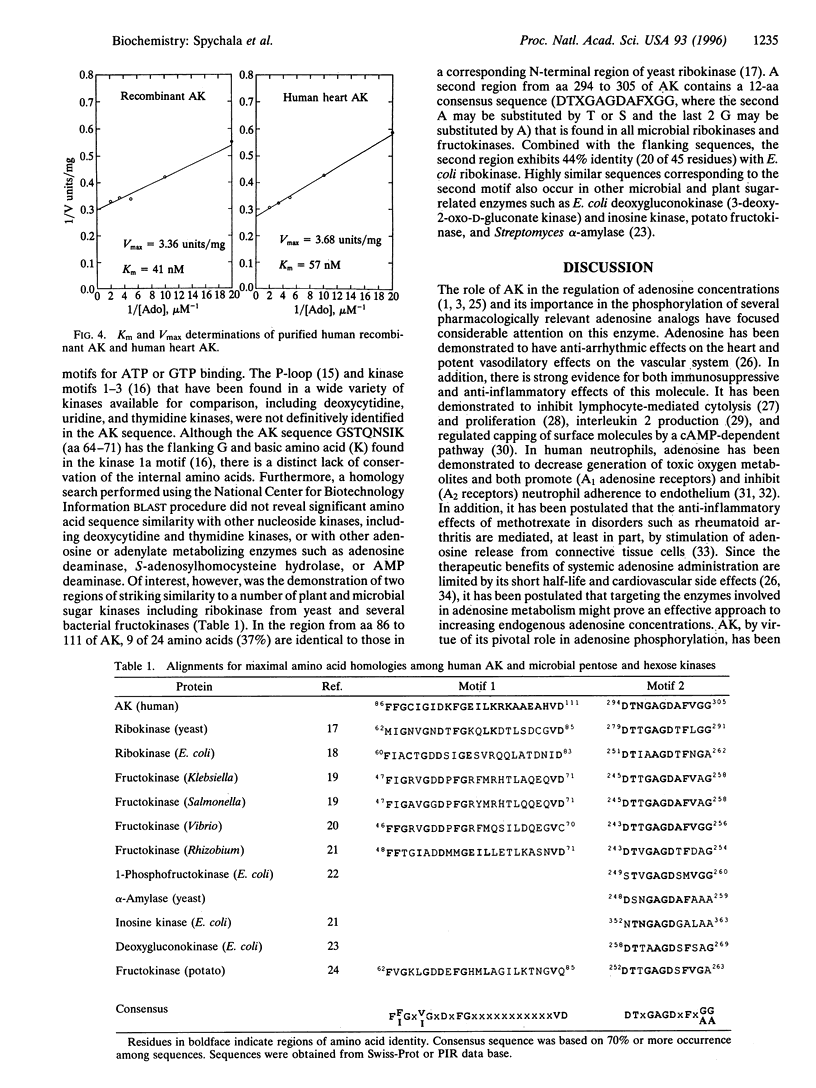
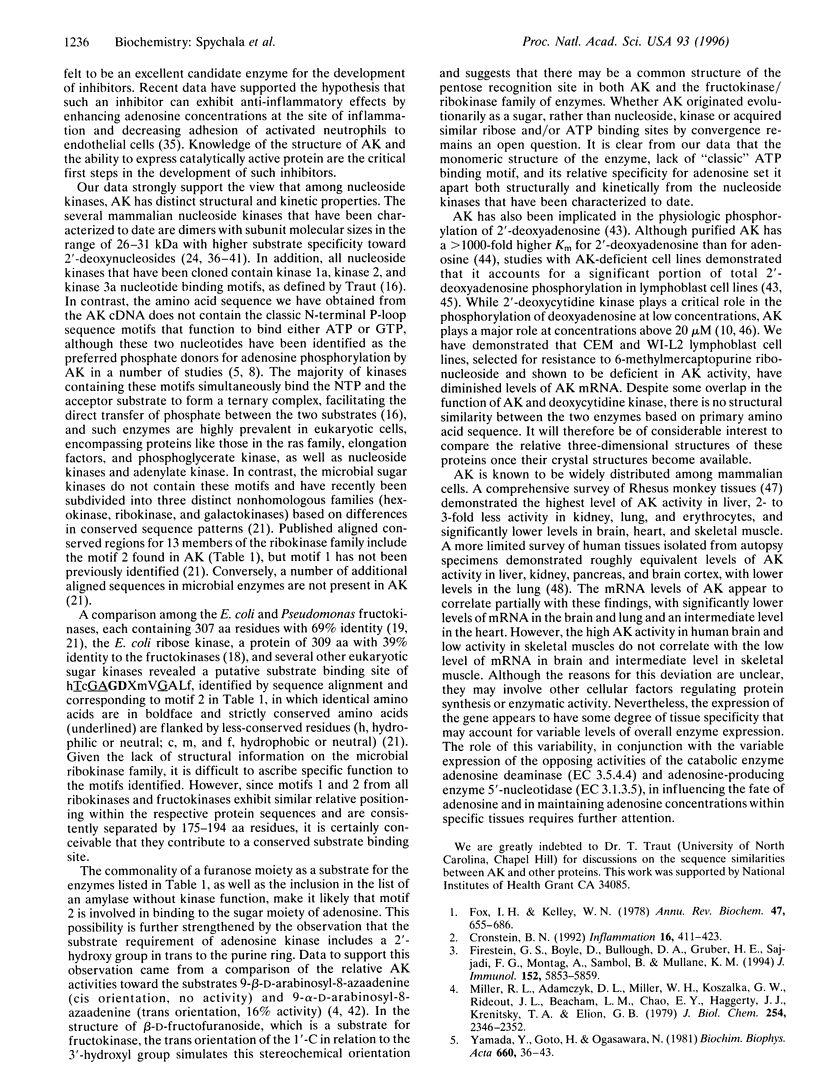
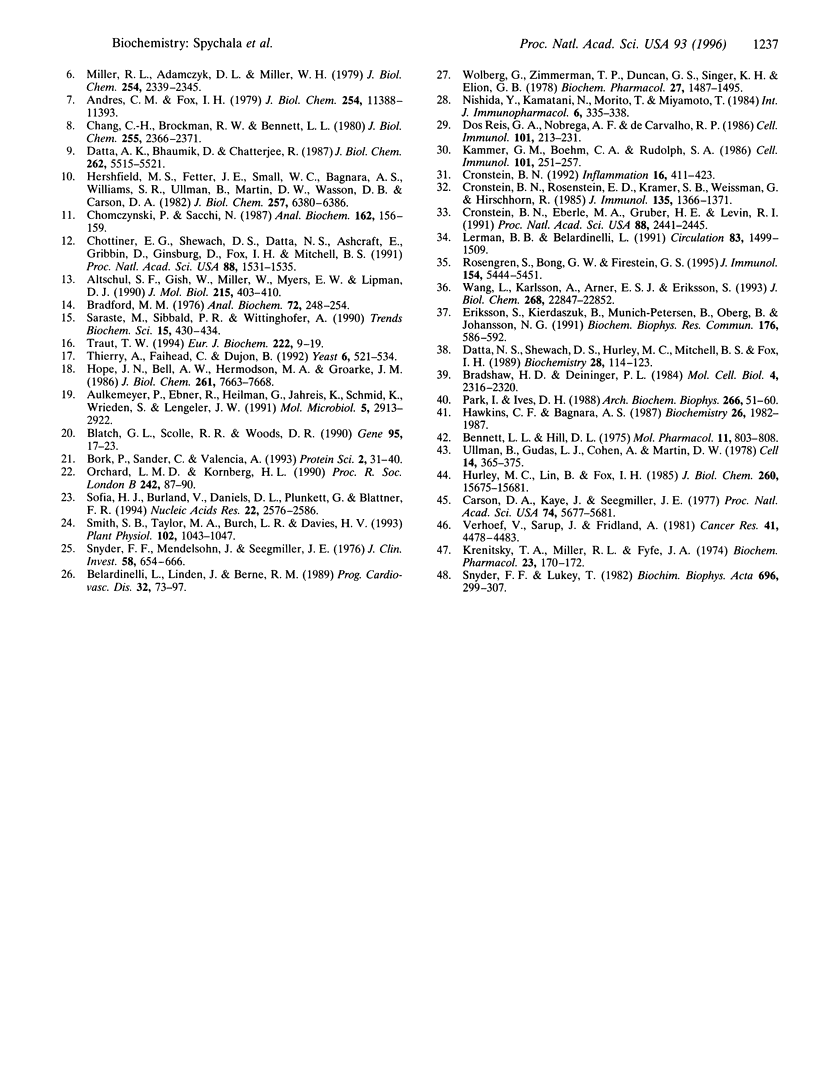
Images in this article
Selected References
These references are in PubMed. This may not be the complete list of references from this article.
- Altschul S. F., Gish W., Miller W., Myers E. W., Lipman D. J. Basic local alignment search tool. J Mol Biol. 1990 Oct 5;215(3):403–410. doi: 10.1016/S0022-2836(05)80360-2. [DOI] [PubMed] [Google Scholar]
- Andres C. M., Fox I. H. Purification and properties of human placental adenosine kinase. J Biol Chem. 1979 Nov 25;254(22):11388–11393. [PubMed] [Google Scholar]
- Aulkemeyer P., Ebner R., Heilenmann G., Jahreis K., Schmid K., Wrieden S., Lengeler J. W. Molecular analysis of two fructokinases involved in sucrose metabolism of enteric bacteria. Mol Microbiol. 1991 Dec;5(12):2913–2922. doi: 10.1111/j.1365-2958.1991.tb01851.x. [DOI] [PubMed] [Google Scholar]
- Belardinelli L., Linden J., Berne R. M. The cardiac effects of adenosine. Prog Cardiovasc Dis. 1989 Jul-Aug;32(1):73–97. doi: 10.1016/0033-0620(89)90015-7. [DOI] [PubMed] [Google Scholar]
- Bennett L. L., Jr, Hill D. L. Structural requirements for activity of nucleosides as substrates for adenosine kinase: orientation of substituents on the pentofuranosyl ring. Mol Pharmacol. 1975 Nov;11(6):803–808. [PubMed] [Google Scholar]
- Blatch G. L., Scholle R. R., Woods D. R. Nucleotide sequence and analysis of the Vibrio alginolyticus sucrose uptake-encoding region. Gene. 1990 Oct 30;95(1):17–23. doi: 10.1016/0378-1119(90)90408-j. [DOI] [PubMed] [Google Scholar]
- Bork P., Sander C., Valencia A. Convergent evolution of similar enzymatic function on different protein folds: the hexokinase, ribokinase, and galactokinase families of sugar kinases. Protein Sci. 1993 Jan;2(1):31–40. doi: 10.1002/pro.5560020104. [DOI] [PMC free article] [PubMed] [Google Scholar]
- Bradford M. M. A rapid and sensitive method for the quantitation of microgram quantities of protein utilizing the principle of protein-dye binding. Anal Biochem. 1976 May 7;72:248–254. doi: 10.1006/abio.1976.9999. [DOI] [PubMed] [Google Scholar]
- Bradshaw H. D., Jr, Deininger P. L. Human thymidine kinase gene: molecular cloning and nucleotide sequence of a cDNA expressible in mammalian cells. Mol Cell Biol. 1984 Nov;4(11):2316–2320. doi: 10.1128/mcb.4.11.2316. [DOI] [PMC free article] [PubMed] [Google Scholar]
- Carson D. A., Kaye J., Seegmiller J. E. Lymphospecific toxicity in adenosine deaminase deficiency and purine nucleoside phosphorylase deficiency: possible role of nucleoside kinase(s). Proc Natl Acad Sci U S A. 1977 Dec;74(12):5677–5681. doi: 10.1073/pnas.74.12.5677. [DOI] [PMC free article] [PubMed] [Google Scholar]
- Chang C. H., Brockman R. W., Bennett L. L., Jr Adenosine kinase from L1210 cells. Purification and some properties of the enzyme. J Biol Chem. 1980 Mar 25;255(6):2366–2371. [PubMed] [Google Scholar]
- Chomczynski P., Sacchi N. Single-step method of RNA isolation by acid guanidinium thiocyanate-phenol-chloroform extraction. Anal Biochem. 1987 Apr;162(1):156–159. doi: 10.1006/abio.1987.9999. [DOI] [PubMed] [Google Scholar]
- Chottiner E. G., Shewach D. S., Datta N. S., Ashcraft E., Gribbin D., Ginsburg D., Fox I. H., Mitchell B. S. Cloning and expression of human deoxycytidine kinase cDNA. Proc Natl Acad Sci U S A. 1991 Feb 15;88(4):1531–1535. doi: 10.1073/pnas.88.4.1531. [DOI] [PMC free article] [PubMed] [Google Scholar]
- Cronstein B. N., Eberle M. A., Gruber H. E., Levin R. I. Methotrexate inhibits neutrophil function by stimulating adenosine release from connective tissue cells. Proc Natl Acad Sci U S A. 1991 Mar 15;88(6):2441–2445. doi: 10.1073/pnas.88.6.2441. [DOI] [PMC free article] [PubMed] [Google Scholar]
- Cronstein B. N. Molecular mechanism of methotrexate action in inflammation. Inflammation. 1992 Oct;16(5):411–423. doi: 10.1007/BF00918968. [DOI] [PubMed] [Google Scholar]
- Cronstein B. N. Molecular mechanism of methotrexate action in inflammation. Inflammation. 1992 Oct;16(5):411–423. doi: 10.1007/BF00918968. [DOI] [PubMed] [Google Scholar]
- Cronstein B. N., Rosenstein E. D., Kramer S. B., Weissmann G., Hirschhorn R. Adenosine; a physiologic modulator of superoxide anion generation by human neutrophils. Adenosine acts via an A2 receptor on human neutrophils. J Immunol. 1985 Aug;135(2):1366–1371. [PubMed] [Google Scholar]
- Datta A. K., Bhaumik D., Chatterjee R. Isolation and characterization of adenosine kinase from Leishmania donovani. J Biol Chem. 1987 Apr 25;262(12):5515–5521. [PubMed] [Google Scholar]
- Datta N. S., Shewach D. S., Hurley M. C., Mitchell B. S., Fox I. H. Human T-lymphoblast deoxycytidine kinase: purification and properties. Biochemistry. 1989 Jan 10;28(1):114–123. doi: 10.1021/bi00427a017. [DOI] [PubMed] [Google Scholar]
- DosReis G. A., Nóbrega A. F., de Carvalho R. P. Purinergic modulation of T-lymphocyte activation: differential susceptibility of distinct activation steps and correlation with intracellular 3',5'-cyclic adenosine monophosphate accumulation. Cell Immunol. 1986 Aug;101(1):213–231. doi: 10.1016/0008-8749(86)90199-1. [DOI] [PubMed] [Google Scholar]
- Eriksson S., Kierdaszuk B., Munch-Petersen B., Oberg B., Johansson N. G. Comparison of the substrate specificities of human thymidine kinase 1 and 2 and deoxycytidine kinase toward antiviral and cytostatic nucleoside analogs. Biochem Biophys Res Commun. 1991 Apr 30;176(2):586–592. doi: 10.1016/s0006-291x(05)80224-4. [DOI] [PubMed] [Google Scholar]
- Firestein G. S., Boyle D., Bullough D. A., Gruber H. E., Sajjadi F. G., Montag A., Sambol B., Mullane K. M. Protective effect of an adenosine kinase inhibitor in septic shock. J Immunol. 1994 Jun 15;152(12):5853–5859. [PubMed] [Google Scholar]
- Fox I. H., Kelley W. N. The role of adenosine and 2'-deoxyadenosine in mammalian cells. Annu Rev Biochem. 1978;47:655–686. doi: 10.1146/annurev.bi.47.070178.003255. [DOI] [PubMed] [Google Scholar]
- Hawkins C. F., Bagnara A. S. Adenosine kinase from human erythrocytes: kinetic studies and characterization of adenosine binding sites. Biochemistry. 1987 Apr 7;26(7):1982–1987. doi: 10.1021/bi00381a030. [DOI] [PubMed] [Google Scholar]
- Hershfield M. S., Fetter J. E., Small W. C., Bagnara A. S., Williams S. R., Ullman B., Martin D. W., Jr, Wasson D. B., Carson D. A. Effects of mutational loss of adenosine kinase and deoxycytidine kinase on deoxyATP accumulation and deoxyadenosine toxicity in cultured CEM human T-lymphoblastoid cells. J Biol Chem. 1982 Jun 10;257(11):6380–6386. [PubMed] [Google Scholar]
- Hope J. N., Bell A. W., Hermodson M. A., Groarke J. M. Ribokinase from Escherichia coli K12. Nucleotide sequence and overexpression of the rbsK gene and purification of ribokinase. J Biol Chem. 1986 Jun 15;261(17):7663–7668. [PubMed] [Google Scholar]
- Hurley M. C., Lin B., Fox I. H. Regulation of deoxyadenosine and nucleoside analog phosphorylation by human placental adenosine kinase. J Biol Chem. 1985 Dec 15;260(29):15675–15681. [PubMed] [Google Scholar]
- Kammer G. M., Boehm C. A., Rudolph S. A. Role of adenylate cyclase in human T-lymphocyte surface antigen capping. Cell Immunol. 1986 Aug;101(1):251–258. doi: 10.1016/0008-8749(86)90202-9. [DOI] [PubMed] [Google Scholar]
- Lerman B. B., Belardinelli L. Cardiac electrophysiology of adenosine. Basic and clinical concepts. Circulation. 1991 May;83(5):1499–1509. doi: 10.1161/01.cir.83.5.1499. [DOI] [PubMed] [Google Scholar]
- Miller R. L., Adamczyk D. L., Miller W. H. Adenosine kinase from rabbit liver. I. Purification by affinity chromatography and properties. J Biol Chem. 1979 Apr 10;254(7):2339–2345. [PubMed] [Google Scholar]
- Miller R. L., Adamczyk D. L., Miller W. H., Koszalka G. W., Rideout J. L., Beacham L. M., 3rd, Chao E. Y., Haggerty J. J., Krenitsky T. A., Elion G. B. Adenosine kinase from rabbit liver. II. Substrate and inhibitor specificity. J Biol Chem. 1979 Apr 10;254(7):2346–2352. [PubMed] [Google Scholar]
- Nishida Y., Kamatani N., Morito T., Miyamoto T. Differential inhibition of lymphocyte function by 2-chloroadenosine. Int J Immunopharmacol. 1984;6(4):335–338. doi: 10.1016/0192-0561(84)90051-1. [DOI] [PubMed] [Google Scholar]
- Orchard L. M., Kornberg H. L. Sequence similarities between the gene specifying 1-phosphofructokinase (fruK), genes specifying other kinases in Escherichia coli K12, and lacC of Staphylococcus aureus. Proc Biol Sci. 1990 Nov 22;242(1304):87–90. doi: 10.1098/rspb.1990.0108. [DOI] [PubMed] [Google Scholar]
- Park I., Ives D. H. Properties of a highly purified mitochondrial deoxyguanosine kinase. Arch Biochem Biophys. 1988 Oct;266(1):51–60. doi: 10.1016/0003-9861(88)90235-4. [DOI] [PubMed] [Google Scholar]
- Rosengren S., Bong G. W., Firestein G. S. Anti-inflammatory effects of an adenosine kinase inhibitor. Decreased neutrophil accumulation and vascular leakage. J Immunol. 1995 May 15;154(10):5444–5451. [PubMed] [Google Scholar]
- Saraste M., Sibbald P. R., Wittinghofer A. The P-loop--a common motif in ATP- and GTP-binding proteins. Trends Biochem Sci. 1990 Nov;15(11):430–434. doi: 10.1016/0968-0004(90)90281-f. [DOI] [PubMed] [Google Scholar]
- Smith S. B., Taylor M. A., Burch L. R., Davies H. V. Primary structure and characterization of a cDNA clone of fructokinase from potato (Solanum tuberosum L. cv record). Plant Physiol. 1993 Jul;102(3):1043–1043. doi: 10.1104/pp.102.3.1043. [DOI] [PMC free article] [PubMed] [Google Scholar]
- Snyder F. F., Lukey T. Kinetic considerations for the regulation of adenosine and deoxyadenosine metabolism in mouse and human tissues based on a thymocyte model. Biochim Biophys Acta. 1982 Mar 29;696(3):299–307. doi: 10.1016/0167-4781(82)90061-6. [DOI] [PubMed] [Google Scholar]
- Snyder F. F., Mendelsohn J., Seegmiller J. E. Adenosine metabolism in phytohemagglutinin-stimulated human lymphocytes. J Clin Invest. 1976 Sep;58(3):654–666. doi: 10.1172/JCI108512. [DOI] [PMC free article] [PubMed] [Google Scholar]
- Sofia H. J., Burland V., Daniels D. L., Plunkett G., 3rd, Blattner F. R. Analysis of the Escherichia coli genome. V. DNA sequence of the region from 76.0 to 81.5 minutes. Nucleic Acids Res. 1994 Jul 11;22(13):2576–2586. doi: 10.1093/nar/22.13.2576. [DOI] [PMC free article] [PubMed] [Google Scholar]
- Thierry A., Fairhead C., Dujon B. The complete sequence of the 8.2 kb segment left of MAT on chromosome III reveals five ORFs, including a gene for a yeast ribokinase. Yeast. 1990 Nov-Dec;6(6):521–534. doi: 10.1002/yea.320060609. [DOI] [PubMed] [Google Scholar]
- Traut T. W. The functions and consensus motifs of nine types of peptide segments that form different types of nucleotide-binding sites. Eur J Biochem. 1994 May 15;222(1):9–19. doi: 10.1111/j.1432-1033.1994.tb18835.x. [DOI] [PubMed] [Google Scholar]
- Ullman B., Gudas L. J., Cohen A., Martin D. W., Jr Deoxyadenosine metabolism and cytotoxicity in cultured mouse T lymphoma cells: a model for immunodeficiency disease. Cell. 1978 Jun;14(2):365–375. doi: 10.1016/0092-8674(78)90122-8. [DOI] [PubMed] [Google Scholar]
- Verhoef V., Sarup J., Fridland A. Identification of the mechanism of activation of 9-beta-D-arabinofuranosyladenine in human lymphoid cells using mutants deficient in nucleoside kinases. Cancer Res. 1981 Nov;41(11 Pt 1):4478–4483. [PubMed] [Google Scholar]
- Wang L., Karlsson A., Arnér E. S., Eriksson S. Substrate specificity of mitochondrial 2'-deoxyguanosine kinase. Efficient phosphorylation of 2-chlorodeoxyadenosine. J Biol Chem. 1993 Oct 25;268(30):22847–22852. [PubMed] [Google Scholar]
- Wolberg G., Zimmerman T. P., Duncan G. S., Singer K. H., Elion G. B. Inhibition of lymphocyte-mediated cytolysis by adenosine analogs. Biochemical studies concerning mechanism of action. Biochem Pharmacol. 1978 May 15;27(10):1487–1495. doi: 10.1016/0006-2952(78)90105-3. [DOI] [PubMed] [Google Scholar]
- Yamada Y., Goto H., Ogasawara N. Adenosine kinase from human liver. Biochim Biophys Acta. 1981 Jul 24;660(1):36–43. doi: 10.1016/0005-2744(81)90105-4. [DOI] [PubMed] [Google Scholar]



